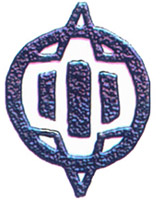No edit summary |
No edit summary |
||
| Line 1: | Line 1: | ||
The '''Thran Empire''' was a massive and ancient civilization way ahead of its time, and possibly the greatest human nation ever on [[Dominaria]]. The Thran created powerful [[artifacts]] and crafted ornate designs into their creations. <ref>{{DailyRef|mtgcom/arcana/485|The Thran symbol|[[Magic Arcana]]|January 20, 2004}}</ref> Although it has long since been in ruins, archaeologists carefully studied its technology for the sake of reverse-engineering, in spite of its age. [[Urza]] and [[Mishra]] in particular were inspired by ancient Thran artifacts. |
The '''Thran Empire''' was a massive and ancient civilization way ahead of its time, and possibly the greatest human nation ever on [[Dominaria]]. The Thran created powerful [[artifacts]] and crafted ornate designs into their creations. <ref>{{DailyRef|mtgcom/arcana/485|The Thran symbol|[[Magic Arcana]]|January 20, 2004}}</ref> Although it has long since been in ruins, archaeologists carefully studied its technology for the sake of reverse-engineering, in spite of its age. [[Urza]] and [[Mishra]] in particular were inspired by ancient Thran artifacts. |
||
| − | [[File:Thran symbol|right]] |
+ | [[File:Thran symbol.jpg|right]] |
== The city-states == |
== The city-states == |
||
It is not known how large the empire truly was, but Thran ruins have been found both in [[Terisiare]] and [[Shiv]], as well as distant [[Caliman]]. Despite its vast size, the power of the empire was centered in eight more-or-less independent city-states: |
It is not known how large the empire truly was, but Thran ruins have been found both in [[Terisiare]] and [[Shiv]], as well as distant [[Caliman]]. Despite its vast size, the power of the empire was centered in eight more-or-less independent city-states: |
||
Revision as of 16:38, 20 August 2014
The Thran Empire was a massive and ancient civilization way ahead of its time, and possibly the greatest human nation ever on Dominaria. The Thran created powerful artifacts and crafted ornate designs into their creations. [1] Although it has long since been in ruins, archaeologists carefully studied its technology for the sake of reverse-engineering, in spite of its age. Urza and Mishra in particular were inspired by ancient Thran artifacts.
The city-states
It is not known how large the empire truly was, but Thran ruins have been found both in Terisiare and Shiv, as well as distant Caliman. Despite its vast size, the power of the empire was centered in eight more-or-less independent city-states:
Of these city-states, Halcyon, Nyoron, and Phoenon were the greatest (in that order), and Phoenon was the most ancient. Halcyon was the capital of the empire from its peak until its collapse. Only the location of Halcyon is known, as it was located on top of a grotto complex named the Caves of the Damned, later known as the Caves of Koilos, which held the portal to Phyrexia.
The empire was ruled by a council of elders, consisting of one delegate of each city. If they couldn’t reach a verdict on a certain matter, the vote was given to a group of 28 “leaders”: artificers, healers, warriors, architects, and others who had done a great deed to help the empire advance.
History
No one knows when the empire was founded. Even the Thran themselves disagreed over whether their nation had existed for centuries or millennia. This unclearness might have something to do with the fact that for only the last hundred years of its existence the empire had a clear seat of power after Halcyon was made the capital.
After Halcyon had solidified its position as capital the war for city-state sovereignty continued, but it took the form of a war between artificers and eugenicists. The two groups both tried to enhance the Thran, but as elite imperialists sided with the artificers and republican rabble with the eugenicists, they were pitted against one another. This conflict ended when the republicans were defeated and all eugenicists exiled. This was only 13 years before the empire would collapse.
Five years later, Glacian, lead artificer of Halcyon, fell ill. Since traditional Thran medicine couldn’t help him, the lead eugenicist Yawgmoth was recalled from his exile. He concluded that Glacian was suffering from phthisis, a disease caused by radiation from the powerstones on which nearly all of Thran technology was based. Using his intelligence, his strategic genius, and his charisma, Yawgmoth managed to become the leading elder of the empire.
During his exile Yawgmoth had made many enemies, who now allied themselves with Chignon, Losanon and Wington, city-states that thought the healer had attained too much power. The Thran Alliance waged war on the empire and took both Phoenon and Orleason without much resistance. In the final battle of the Thran Civil War, the Battle of Halcyon, they were defeated by Yawgmoth’s forces who had been mutated in Phyrexia. In this battle, Halcyon itself was destroyed, with all its inhabitants either dying or joining Yawgmoth. Shortly after this the entire empire collapsed.
References
- ↑ Magic Arcana (January 20, 2004). "The Thran symbol". magicthegathering.com. Wizards of the Coast.
- ↑ The names of the states (save for Halcyon) were inspired by American major cities: New York, Seattle, Phoenix, (New) Orleans, Chicago, Los Angeles and Washington.

